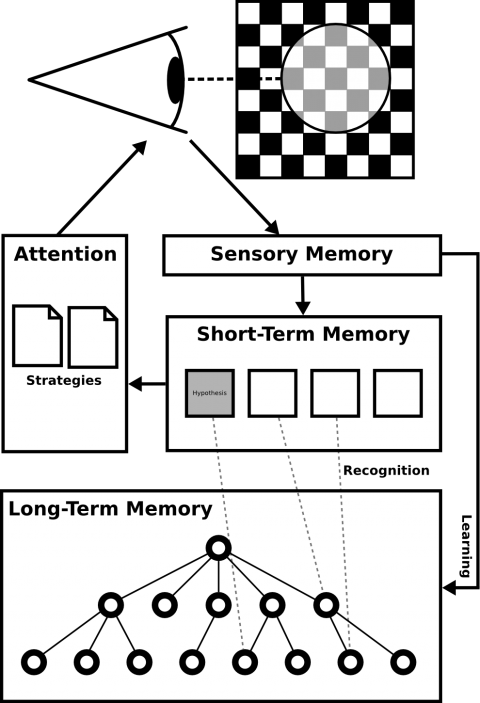CHREST
Home * Knowledge * Cognition * CHREST
CHREST, (Chunk Hierarchy and REtrieval STructures)
a cognitive architecture that models human perception, learning, memory, and problem solving. It is distinctive in its emphasis on the importance of perception and attention, and in following human constraints such as limitations on short-term memory, chunking and processing speed. Fernand Gobet is principal investigator of CHREST, influenced by the earlier EPAM model, originally designed by Herbert Simon and Edward Feigenbaum [1] [2].
CHREST consists of a blending of ideas proposed in earlier computer models of different aspects of chess [3], Mater by Baylor and Simon [4], Perceiver by Barenfeld and Simon [5], and MAPP by Gilmartin and Simon [6] and originated from modeling work on chess expertise.
CHUMP
One application of CHREST was the pattern learning chess program CHUMP by Gobet and Peter Jansen [7] , where an eye movement simulator, the only part of the system where the rules of the game influence the learning process, scans the board, and directs its attention to pieces and squares it expects, given the current node in its discrimination net, attack, defense and proximity relations between pieces.
Architecture
An overview of the architecture of CHREST [8]
See also
Publications
- Fernand Gobet (1993). A Computer Model of Chess Memory. Proceedings of the 15th Annual Meeting of the Cognitive Science Society, pp. 463-468.
- Fernand Gobet, Peter Jansen (1994). Towards a Chess Program Based on a Model of Human Memory. Advances in Computer Chess 7
- Adriaan de Groot, Fernand Gobet (1996). Perception and memory in chess. Heuristics of the professional eye. Assen: Van Gorcum, The Netherlands. ISBN 90-232-2949-5. Chapter 9; A discussion: Two authors, two different views? word reprint.
- Fernand Gobet, Herbert Simon (2000). Five Seconds or Sixty? Presentation Time in Expert Memory. Cognitive Science, Vol. 24, No. 4
- Fernand Gobet, Peter Lane, Steve Croker, Peter C-H. Cheng, Gary Jones, Iain Oliver, Julian M. Pine (2001). Chunking mechanisms in human learning. Trends in Cognitive Sciences, Vol. 5, No. 6
- Fernand Gobet (2001). Is Experts' Knowledge Modular? Proceedings of the 23rd Meeting of the Cognitive Science Society, pdf
- Pertti Saariluoma, Tei Laine (2001). Novice construction of chess memory. Scandinavian Journal of Psychology, Vol. 42, No. 2
- Fernand Gobet, Peter Lane (2004). CHREST tutorial: Simulations of human learning. CogSci 2004
- Fernand Gobet (2005). Chunking Models of Expertise: Implications for Education. Applied Cognitive Psychology, Vol. 19, No. 2
- Fernand Gobet (2007). Chunk hierarchies and retrieval structures: Comments on Saariluoma and Laine. Scandinavian Journal of Psychology, 42. pdf
- Richard L. Smith, Fernand Gobet, Peter Lane (2007). An Investigation into the Effect of Ageing on Expert Memory with CHREST. UKCI 2007
- Peter Lane, Fernand Gobet, Richard L. Smith (2008). Attention mechanisms in the CHREST cognitive architecture. Proc. of the 5th International Workshop on Attention in Cognitive Systems
- Roy W. Roring III (2008). Reviewing Expert Chess Performance: A Production-Based Theory of Chess Skill. Ph.D. thesis, advisor Neil Charness, Florida State University
- Richard L. Smith, Fernand Gobet, Peter Lane (2009). Checking chess checks with chunks: A model of simple check detection. ICCM 2009
External Links
- CHREST from Wikipedia
- CHREST Home
- Design of CHREST
- Flora Purim - Open Your Eyes You Can Fly, YouTube Video
References
- ↑ Edward Feigenbaum (1959). An Information Processing Theory of Verbal Learning. RAND Paper
- ↑ Edward Feigenbaum, Herbert Simon (1984). EPAMlike models of recognition and learning. Cognitive Science, Vol. 8, 305-336, pdf
- ↑ Fernand Gobet (1993). A Computer Model of Chess Memory. Proceedings of the 15th Annual Meeting of the Cognitive Science Society, pp. 463-468
- ↑ George W. Baylor, Herbert A. Simon (1966). A chess mating combinations program. AFIPS
- ↑ Herbert Simon, Michael Barenfeld (1969). Information-processing analysis of perceptual processes in problem solving. Psychological Review, Vol. 76, No. 5
- ↑ Herbert Simon, Kevin J. Gilmartin (1973). A Simulation of Memory for Chess Positions. Cognitive Psychology, Vol. 5, pp. 29-46.
- ↑ Fernand Gobet, Peter Jansen (1994). Towards a Chess Program Based on a Model of Human Memory. Advances in Computer Chess 7
- ↑ Design of CHREST
